Annual Oration 1966
By David P. Boyd, M.D.
It would be more affectation than candor if I did not acknowledge my sense of pleasure on this occasion. When one contemplates the roster of previous orators, 157 in all, it is apparent that it includes some of the greatest physicians in the history of Massachusetts. When one further scans the subjects chosen by these giants of the past, it becomes evident that they have been widely dissimilar. Some of my predecessors have preferred what was obviously an abiding medical or surgical passion, and the resulting discourse is the distillate of a lifetime's preoccupation. Others have found this an opportunity to discuss moral, philosophical, religious or community problems. The immunity from open discussion that such a discourse provides allows certain liberties; yet there are also formidable inhibitions. Chief among these is the awesome prospect of attempting to say something worthy of the occasion.
When I was honored in this way, I cast about for a theme and a title for my remarks. I have often said that if I had to preach a lay sermon I would speak on the subject of discretion, a quality so much less common in our profession than intelligence. Musing on this topic of discretion led to thoughts of seeing as though one sees not, and this is, with a slightly different meaning, the central theme of my remarks. Seeing without observing completely may come from seeing too much. "Experience," said Osier, "consists not in seeing much, but in seeing wisely." I wonder what we could do to teach this to those beginning their medical careers? I wonder how we could remind ourselves of this again and again?
The subject at hand today is not taken as an example of "vulgar errors" or "public notions are always wrong." Rather, it is offered as an expression of the value of approaching a familiar but confusing problem afresh after waging active combat with one's own and others' convictions. It is hoped that this brief presentation will not appear pedantic or even pedagogic. Surely, one does not have to be exceptional to communicate something of value to one's fellows. Indeed, the best teachers seem to be those who have themselves known difficulties and are intent on being helpful rather than dazzling.
The lesson that I should like to emphasize was learned in elementary psychology in school or college. William James called it "Believing is seeing," and gave full accounts of some of its forms. Reflection suggests that this could be an incredibly destructive force in our daily lives and in our attempts to reach these truths, which are God's natural laws. With this as an underlying theme, I propose to discuss one small but complex area of surgical anatomy and its pathology, using a quaint old children's tale as an obbligato.
"Beauty," said the sage of Athens, "is the splendor of truth." Each generation and doubtless all philosophers have attempted an analysis of beauty and truth. All such efforts seem drab and pale when compared to Plato's transcendent thought. If beauty is indeed the splendor of truth, the century-old appeal of Hans Christian Andersen is readily explained. With 137 tales to choose from, each will have his favorite, but few stand out in the memory more vividly than the story of The Emperor's New Robes. It may be assumed that in childhood the satire was not understood any more than the older child grasps the pungent depths of Gulliver's Travels. Yet the splendor of truth is so sure that it reaches the sensibilities of the young. Children, it seems, approach reality instinctively and directly — that is, without the need for intermediaries. It is only when the child grows older and becomes increasingly dependent upon and influenced by adult interpretation of environment that such allegories leave him inert. Occasional adult exceptions can be found, of course, but they are usually seen in the poet and the artist.
It will be recalled that in the common version of the fable, a pair of swindling itinerant tailors persuaded the Emperor to give them larger and larger quantities of golden thread to weave his new robes. These robes were to be the most luxurious ever known and so light they would appear weightless. The rebuking satire, ill concealed at this point, does not concern us now. However, the incredibly ingenious tinkers succeeded in convincing the incredibly ingenuous ruler and his court that the robes would be invisible to certain of his followers. Yet to those who saw them they would be breathtaking in their beauty. As the story unfolds the effects of the tailors' hypnosis are seen. One after the other, the citizens applaud the golden robes as the procession goes by. Did any of the courtiers doubt that the robes were there at all, or that they were of the most spectacular sort? If so, he kept it to himself. Whatever the impact on his sense organs, the ultimate result was the same. Each one immediately said that he saw what he was told was there. It was the innocent apprehension of childhood that finally pricked the bubble. "But the Emperor has no clothes on," a little boy said, and his father apologized for him.
Perhaps the reason this story of three short pages is so capturing lies in the variety of its implications. It succeeds in touching on a myriad of human weaknesses that the author then leaves the reader to sort out for himself. It is the kind of work of art that one examines and then puts aside in order to think. Gradually, a glimpse of nature is revealed – nature as it really is – pleasant or not. This story shows, above all, how potent and how stable, how astonishingly stable, are the thought patterns of a people or an era. This is the prime message of the story of The Emperor's New Robes.
When accused of being frivolous, Bernard Shaw once replied, "When something is funny, look for the hidden truth." With all due respect to G.B.S., the search for truth does not keep one grinning all the time. "When something is funny, look for the hidden truth," may be paraphrased for our purpose today, by saying, "When something is confusing, look for the hidden untruth." Indeed, this might be advanced as an axiom in our context of subphrenic anatomy and infection. We shall try to prove it.
As a graduate student teaching anatomy, I realized that there were few subjects that caused greater confusion to teacher and student than the subphrenic spaces. The traditional data and dicta in some way did not ring true; they failed to impart a sense of actuality – thus, they were confusing. As a practicing surgeon, personal experience with a large number of abscesses in these spaces as part of an active general surgical service in a group did not resolve this pervading unreality. Subphrenic-space infections, with their frequent intrathoracic complications, were willingly turned over to the chest surgeon, who, in recent decades, has been inured to challenges not readily met. Thus, as an increasing concentration of these serious problems fell into a few hands in our institution, it became imperative to make some attempt to unravel the tangled story of the spaces above the liver and their infections. It was only after The Emperor's New Robes had been looked at again and again for many troublesome sessions that something that might be called a key to the subject was found.
In a series of lectures before the Royal Society of Medicine in 1907 Barnard gave a detailed anatomic description of the subphrenic spaces. Barnard so effectively clothed the emperor that a generation of surgeons lost its vision. Without exception, every major contribution on this subject since that time refers to Barnard's work and in most cases accepts it. One of our own drawings from many years ago (Fig. 1) shows where the error lies and where the confusion begins. The crux of the problem rests in the location of the ligamentous attachments of the liver. The coronary ligament is usually shown as suspending the liver from the diaphragm superiorly as in our diagram (Fig. 1). A few minutes in the operating room or in the dissecting room will show unequivocally that this is not so. In actual fact the coronary ligament suspends the liver from the parietes posteriorly, as pointed out by Mitchell in one of the few clear and rational descriptions of this area in the literature. The suspensory ligaments of the liver are dorsal in common with other ligaments and mesenteries of the viscera. Harley has found this to be true also and has suggested that this may be a phylogenetic indication of our four-footed origin. As traditionally described by Barnard and most writers, however, the ligaments divide the superior surface of the liver into anterior and posterior spaces, right and left. It is not surprising that the nomenclature is cumbersome and unreal, for it attempts to define spaces that, like the Emperor's Robes, are not there. When the relations of the liver and diaphragm are carefully drawn, it is seen that the right posterior superior subphrenic space is an anatomic myth. It simply does not exist (Fig. 2 A and B). When it is recalled that in the collected series of Ochsner and DeBakey the right posterior subphrenic space was the most frequent site of infection (Table 1) the importance of a closer look at this anatomy becomes evident.
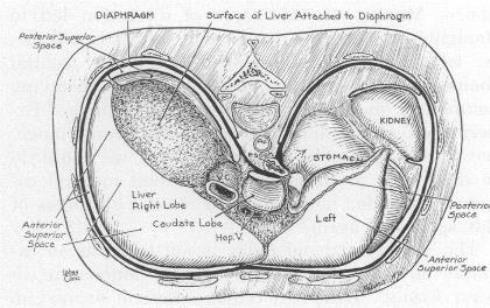
Figure 1: Usual Type
of Drawing Suggesting the Presence Anatomically of Anterior and Posterior
Spaces on Both Sides.
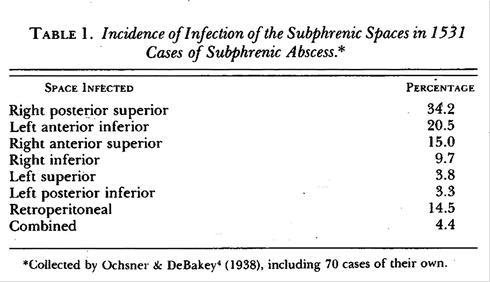
Table 1: Incidente of
Infection of the Subphrenic Spaces in 1531 Cases of Subphrenic Abscess.
On the left side, likewise, there is no subphrenic space lying posterior to the triangular ligament and yet superior to the liver. Experience with large numbers of repairs of hiatal hernias during which the left triangular ligament is divided over to the inferior vena cava and the great hepatic veins gives one conviction in this matter.
Gratitude is expressed to Joseph E. Strode, of Honolulu, for the drawing seen now (Fig. 3). This, I believe, makes it further apparent that the attachments of the liver are posterior, and there is but 1 space above the liver on the right side and 1 on the left separated by the falciform ligament. If, instead of Barnard's 6 spaces above the liver, we think of only 2, something might be achieved for simplicity and accuracy.
As is so often found when light dawns and the moths finally fly away from a shabby area of thought, similar conclusions had been arrived at before but were buried in the oblivion of medical literature.
At the time of my earlier writings on this subject, I was aware of only some of the English contributions. Superlative students of anatomy and pathology as they are, they have endeavored to clarify this bewildering region. Unfortunately, Harley and Mitchell have not presented their work in the American literature.
It seems proper at this point to touch on the significant contributions of Alton Ochsner to this subject. Figure 4 shows the most familiar diagram in the literature on subphrenic abscess. I should like to insist that there is nothing here expressed or implied that should detract from Dr. Ochsner's sterling contributions to the therapy of subphrenic abscess. His operation undoubtedly saved countless lives. This operation, I am sure, served to keep surgeons out of the peritoneum and especially the pleura. But is this abscess in the subphrenic space? Surely, it is clear that this collection is not subphrenic at all but actually subhepatic. And since Barnard specifically excluded all but abscesses above the liver in the first paragraph of his address, confusion enters the court and reigns supreme.
, Usually Depicted as Dividing the Superior Surface of the Liver into Anterior and Posterior Spaces..jpg)
Figure 2: Right
Triangular Ligament (A), Usually Depicted as Dividing the Superior Surface of
the Liver into Anterior and Posterior Spaces (This Error Is Sometimes Even More
Exaggerated than Shown Here) as Compared with the Proper Anatomic Relation (B).
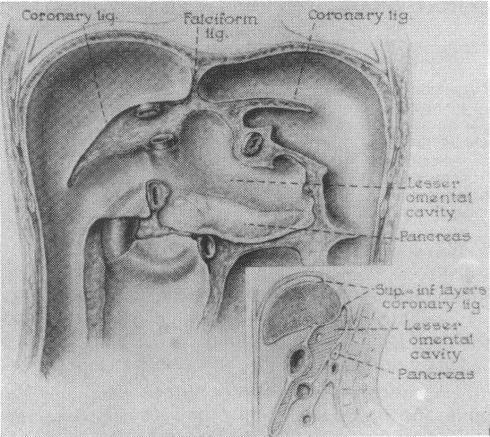
Figure 3: Posterior
Location of the Right and Left Coronary Ligaments, Well Shown in These Drawings
(Reproduced from Strode, with the Permission of the Publisher).
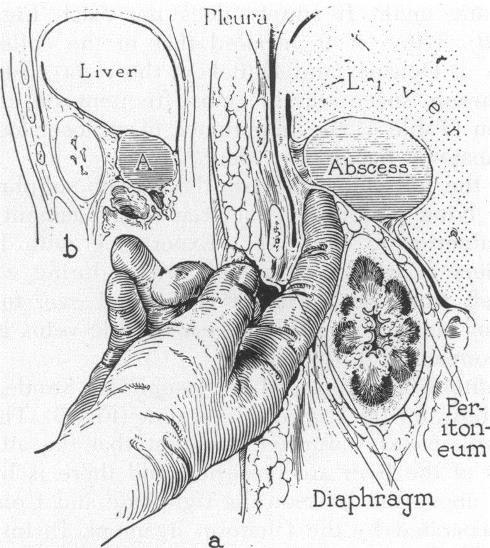
Figure 4: Key Figure
from Ochsner's Classic Study on Subphrenic Abscess (Reproduced from Ochsner and
Graves with the Permission of the Publisher).
Parenthetically, it is of interest to note how this perplexing situation was handled by a responsible American author. In the second edition of Calender's textbook of Surgical Anatomy a compromise position is reached. Apparently, traditional descriptions did violence to the conscience of the anatomist. It is seen that there is but 1 space above and 1 space below the liver (Fig. 5 A).
..jpg)
Figure 5: Surgical
Anatomy of the Subphrenic Spaces as Described by Callander (A), in Which the
Divisions Indicated Are Artificial and the Familiar Ochsner Drawing Shown in
Figure 4, with Changes in Nomenclature (B) by Callander (Reproduced from Callander
with the Permission of the Publisher).
Nothing is said of a right posterior superior space, which, as stated, has been most frequently involved in abscess formation. This compromise involves the division of these very large spaces into compartments anterior and posterior. Although certainly not inaccurate and undoubtedly useful in reference to the location of abscesses, this designation, it must be remembered, is quite artificial. There are no partitions above the liver except for the falciform ligament unless they are caused by pyogenic membranes. How did the perceptive Dr. Callander deal with the surgical anatomy of "right posterior superior" abscesses? It is apparent (Fig. 5 B) that he rejected the time-honored classification of Barnard. We see in his modification of the familiar Ochsner drawing that the right posterior subphrenic abscess is now termed posterior subhepatic. Is this a triumph for clear thinking and accuracy, or is it merely a matter of names? Precise knowledge of anatomy is essential for the appreciation of pathogenesis and morbidity; this in turn is the basis of rational surgical treatment. Although Barnard's work rendered subphrenic anatomy complex and unintelligible, he did insist that abscesses in the subphrenic spaces be separated from subhepatic collections (Fig. 6).
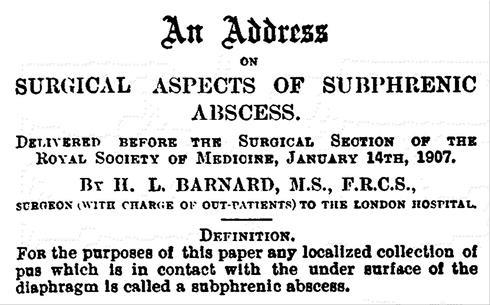
Figure 6: Barnard's
Definition of Subphrenic Abscess (Reproduced from Barnard with the Permission
of the Publisher).
Future generations remembered the former and forgot the latter. It would have been much better the other way. Experience has shown that abscesses in these spaces above and below the liver behave quite differently from each other. They vary substantially as problems in diagnosis, in type and magnitude of complications and in the technic of operative drainage.

Figure 7: Large Size
of the Single Subphrenic Space (A), the Position of the Supporting Ligament
Being Posterior, and Harley's Representation (B) of the Ochsner Approach
(Reproduced from Harley with the Permission of the Publisher).
Let us turn again to the British successors to Barnard and see what they did in their attempts to clarify this anatomy. Here is a drawing (Fig. 7 A) from Harley, who credits it to Mitchell. By the criteria already considered the drawing is accurate — the terminology clear. Right and left spaces, suprahepatic and infrahepatic, are indicated. In the next drawing, also taken from Harley, are some representative subphrenic collections (Fig. 7 B). But where is the ligament? Where are these abscesses located? One is left in doubt. Mr. Harley stated that, "For the purpose of this discussion, the subphrenic area will be taken to include the area from the diaphragm above to the mesocolon below...." This is in keeping with recent practice, but I will try to show that it is undesirable. Mr. Harley goes on to say, "The right superior hepatic space described by me includes the right posterior superior and the right anterior superior spaces of Ochsner and DeBakey." Because this statement is an integral part of Mr. Harley's important monograph on this subject, I should like, with his permission, to quote a paragraph from a recent letter to me: "With regard to your query regarding the right posterior superior space, I do not think there is such a space. This space as described by Ochsner and DeBakey (1938) is, I believe, the posthepatic recess of the right infrahepatic space as depicted in Fig. 1, Page 5, of my monograph, and as I describe it at the top of Page 8. As you say, this area is infrahepatic." Mr. Harley graciously goes on to state that he thinks that the ligaments in his illustration are shown too high. In 1955 this interesting subject was the basis of a Hunterian lecture by Mr. Harley before the Royal College of Surgeons of England.
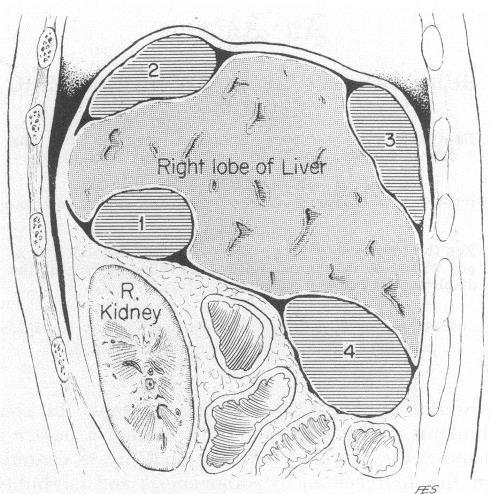
Figure 8: Approaches
to Subphrenic Abscesses.
This small region of surgical anatomy is of interest only partly for its value as an exercise in clear and honest thinking. It will now be suggested that this subject is not too resolutely academic but has positive practical connotations.
First among these is the significantly higher incidence of intrathoracic complications when the infection is located above the liver. In 128 subphrenic and subhepatic abscesses reviewed in 1958 we could find no instance of pleural effusion in a patient whose collection was subhepatic unless heart disease was also present. Pleural effusion in a postoperative patient means subphrenic infection in most cases. It was present in 35 per cent of ours.
Perforation into the chest is the most dangerous fate that may befall these patients. In our experience it has occurred only with true subphrenicspace abscess and is an important reason for accuracy in separating the different types. Unlike the solid liver, the soft diaphragm and lung yield to exudate. A fulminating empyema results that is rapidly fatal unless drained. If the lung is fused to the parietal pleura a bronchial fistula develops. A sudden catastrophic flooding of the bronchial tree with purulent exudate occurs.
Our experience with post-traumatic strictures of the biliary ducts has given us an occasional case of subphrenic biliary abscess secondary to obstructive jaundice with leakage of bile. Some of these have had acute or chronic perforation into the pleural cavity or bronchial tree. The stabilization of the intrathoracic dynamics is of critical importance in these patients as an emergency procedure, but cure results only when adequate drainage of the subphrenic space is combined with correction of the lesion in the biliary tract.
The final argument for precise definition of these spaces and their infections is related to technics of surgical treatment. Details of surgery will not be covered here. They are referred to only to argue for the basic premise and make it plausible.
Abscesses located in the back of the subhepatic space (Morison's pouch) are simply and easily reached through the bed of the twelfth rib (Ochsner). This is safe and direct and is extraperitoneal and extrapleural. One has the impression that the so-called right posterior superior subphrenic abscesses that were so common in former years after appendicitis with perforation were not really subphrenic at all but actually subhepatic — that is, in Morison's pouch. Today, with increasing numbers of operations on the liver, pancreas, biliary tree, spleen and abdominal esophagus, abscesses above the liver and in the lesser sac appear to be more frequent. It is hard to conceive that a truly subphrenic abscess, as shown in Figure 8, can be reached by anything other than a transpleural approach. This has been our standard practice for many years. We have had no reason to believe that fear of pleural contamination should deter us from the most direct approach to the infection. This was described by Clute from our group in 1926. Despite the worldwide impact of Ochsner's work published in 1933, 1938, and again in 1940, Lahey said in 1944, "With immediate operation [that is, after needling], the two leaves of the diaphragm can be sutured and immediate decompression of the abscess can be instituted"–this from a man widely known for his espousal of two-stage operations, especially where infection was a factor. The operation is done today very much as Dr. Lahey described it. Experience through the years has persuaded us that the mortality of subphrenic abscess is not increased by transpleural drainage. This mortality is related to our wit in diagnosing the lesion and to the severity of the underlying disease.
If confusion is the sister of error – and I have tried to show this today – order and simplicity are the handmaidens of truth. It seems that the scientific method considered primarily as a means for seeking truth may be beyond the reach of the common man. Nevertheless, even the humblest of us, plodding wayfarers as we may be, can contribute to our own growth and perhaps even to the world's betterment. To do this we might remember that the methods of science are not exclusively a means for searching out truth; they are also concerned with the search for error. William James said, "The So-Called fallacy of the senses of which the ancients made so much account is not fallacy of the senses proper but rather of the intellect which interprets wrongly what the senses give."
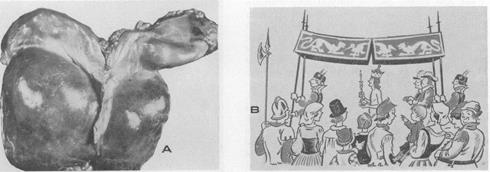
Figure 9: "'But
the Emperior Has No Clothes on,' the Little Boy Said, and His Father Apologized
for Him."
Each one of us has an inborn desire to contribute in some unique or personal way to our life's work. It may be that here is a formula that some may find useful. I have suggested that when some field is especially confusing there is an underlying discrepancy with fact. Our assignment, then, is to try to be in our maturity as intelligent and receptive as we were in childhood – a tall order.
But only in this way can we remove the Emperor's golden robes (Fig. 9), which may be clothing a hundred treasured credos that we practice and preach every day.
_______________
Boyd, David P. "The Subphrenic Spaces and the Emperor's New Robes." New England Journal of Medicine 275, no. 17 (1966): 911-17.
View all Annual Orations
